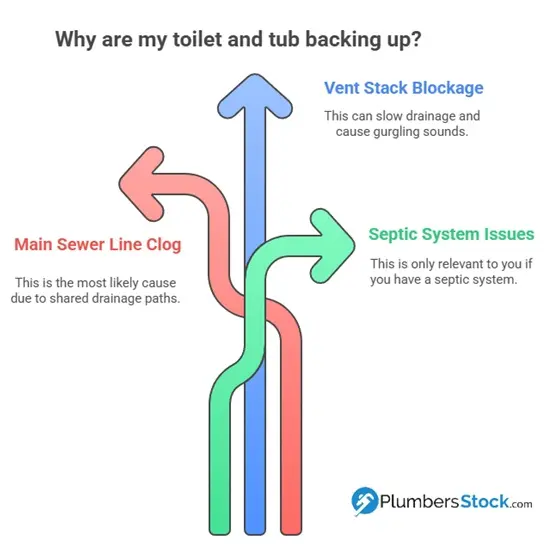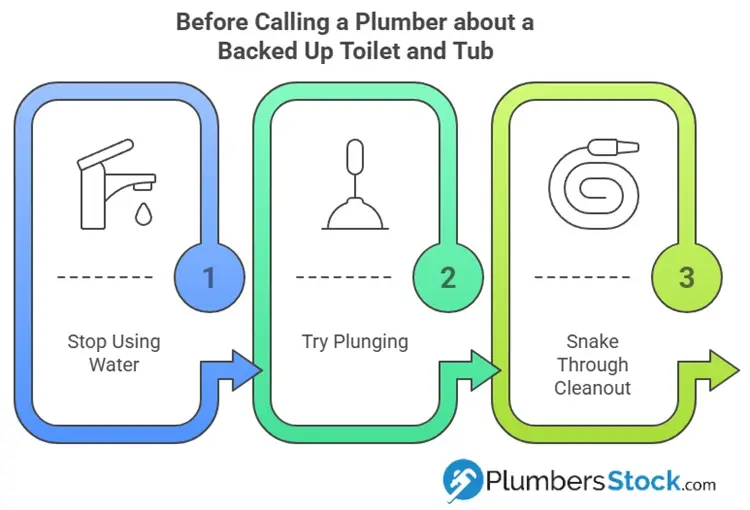If your toilet and bathtub are both backing up, it’s a clear sign of a plumbing issue that needs immediate attention. This kind of problem typically points to a clog or blockage in the main drain line, rather than an isolated fixture issue. Understanding the causes and solutions can help you take the right steps, whether you’re tackling it yourself or calling in a pro. In this guide, we’ll explain:
- Common reasons why toilets and tubs back up at the same time
- How to diagnose the issue
- DIY fixes you can try
- When it’s time to call a plumber
Why Are My Toilet and Tub Both Backing Up?
 When both your toilet and tub are backing up, it usually means there’s a blockage in your home’s main drain or sewer line. These fixtures often share the same drainage path, so a clog downstream affects them both.
When both your toilet and tub are backing up, it usually means there’s a blockage in your home’s main drain or sewer line. These fixtures often share the same drainage path, so a clog downstream affects them both.
Common Causes
Main Sewer Line Clog:
This is the most likely culprit. Wastewater from all your drains flows through one main sewer line. If this pipe becomes clogged by:
- Tree roots
- Grease buildup
- Flushed non-flushables (like wipes or feminine products)
Vent Stack Blockage:
Your plumbing system uses vent pipes to equalize pressure and allow water to flow smoothly. A blocked vent stack can slow drainage and lead to gurgling sounds or backups.
Septic System Issues (if applicable):
If you have a septic system, an overflowing tank or failed drain field could cause sewage to back up into tubs and toilets.
“When you see simultaneous backups in low-level fixtures like tubs and toilets, it almost always means there’s a problem with the main line—not just a localized clog,” says licensed plumber Mike D.
Signs You Have a Main Line Clog
- The toilet bubbles when you drain the tub
- Water backs up into the tub after flushing
- Slow drainage across multiple fixtures
- Foul odors coming from drains
What You Can Do Before Calling a Plumber
Step 1: Stop Using Water
Avoid flushing toilets or running water anywhere in the house until you’ve identified the source of the issue—otherwise, you risk flooding.
Step 2: Try Plunging
Use a heavy-duty flange plunger on your toilet first. If water moves between fixtures (e.g., plunging makes water rise in tub), stop—it confirms a deeper clog.
Step 3: Snake Through Cleanout
If you’re handy and have access to an outdoor cleanout pipe (usually near where your main sewer exits), use a long auger or rented power snake to clear blockages from there.

According to Kohler’s residential plumbing guide: “For persistent clogs affecting multiple bathroom fixtures, homeowners should inspect their cleanout access point before attempting internal fixture repairs.”
When To Call A Professional Plumber
You should contact professional help if:
- The backup persists despite repeated attempts
- You don’t have access to—or aren’t comfortable using—a cleanout
- Sewage is coming out of the drains (this is considered an emergency)
Professional plumbers have tools like camera inspections and hydro jetters that can safely remove deep obstructions without damaging pipes.
Prevent Future Backups

To avoid recurring problems:
Only flush toilet paper—no wipes or hygiene products
Don’t pour grease down kitchen sinks (it hardens downstream)
Install hair catchers in tubs/showers
Schedule regular sewer line inspections if trees grow near the lines
Also, consider upgrading older toilets with more efficient models available at PlumbersStock.com Toilets Section. Modern designs use less water while maintaining strong flush power, reducing strain on your system overall.
Helpful Products for Maintenance & Prevention
Explore these helpful items at PlumbersStock:
- Toilet augers for clearing clogs manually
- Wax rings & bolts if resealing is needed after inspection
- New toilet seats if yours gets damaged during removal
And if you’re considering upgrades:
One-piece toilets for easier cleaning
Built-in bidet toilets for added comfort
FAQ: Toilet & Tub Backup Problems
Q: Why does my tub fill with water when I flush my toilet?
A: This usually indicates that wastewater can’t flow freely through your main drain line due to a clog further down the system.
Q: Can I fix this myself without calling a plumber?
A: Possibly! If you’re comfortable using basic tools like plungers or snakes—and have access to an exterior cleanout—you may be able to clear minor clogs yourself.
Q: Is this dangerous? Could sewage come into my home?
A: Yes. If left untreated, severe blockages can cause raw sewage backups inside bathrooms—a serious health hazard requiring professional cleanup.
Q: Will chemical drain cleaners work?
A: Not recommended for major blockages—they often don’t reach deep enough into pipes and may damage older plumbing over time.
Resources
Here are two helpful resources that go deeper into diagnosing sewer line issues:
By understanding how shared drainage systems work—and knowing what signs point toward bigger issues—you’ll be better prepared next time something goes wrong with your toilet or tub. For replacement parts, upgrades, or maintenance tools, visit our full bathroom selection at PlumbersStock.
About the Author
Cliff is a proud Dad and already a Grandpa, if you can believe it! He likes to lift weights, play basketball, hunt, and do just about anything outside. He has been in the construction and plumbing business off and on since 1989 and has tons of experience in many areas of home improvement.
